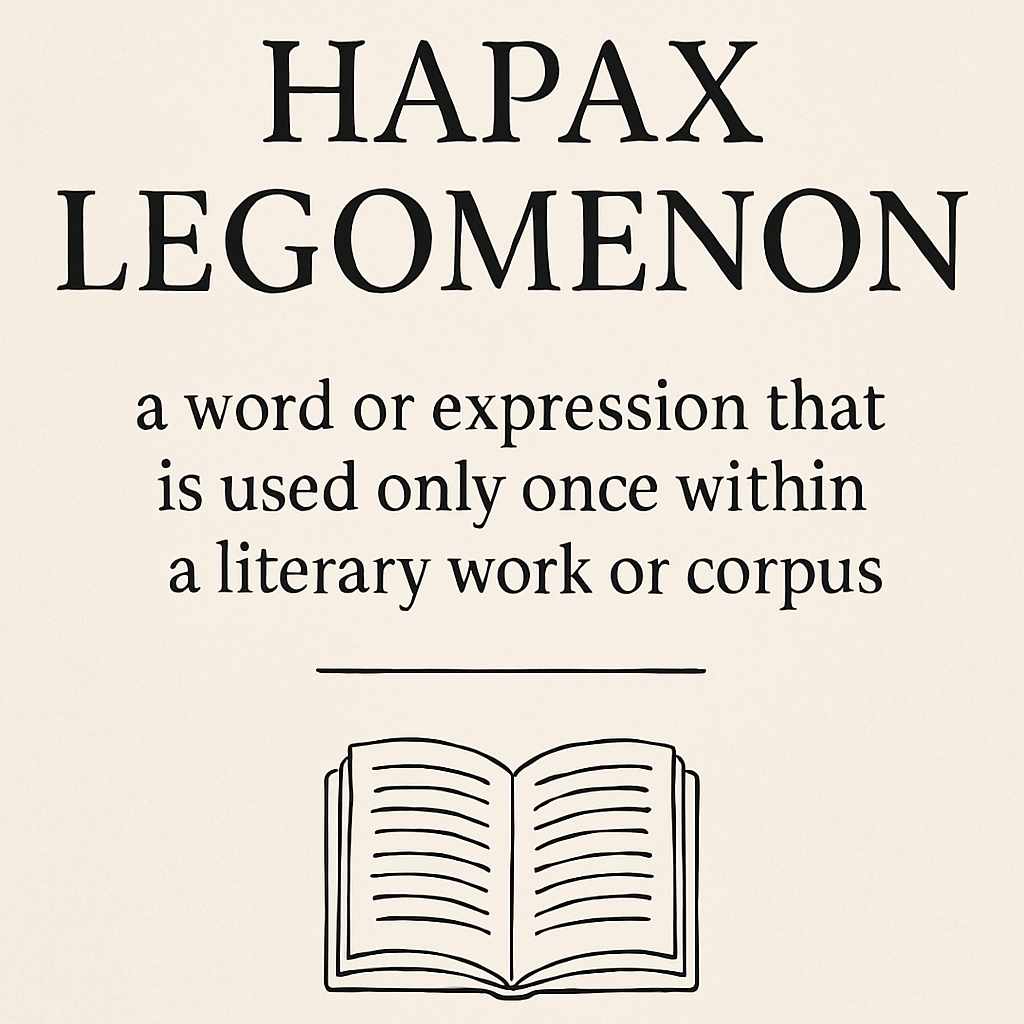Have you ever stumbled upon a word in a book that feels completely unfamiliar, one that seems to appear out of nowhere, leave behind a strange and fleeting impression, and then vanish forever? There is a name for that kind of occurrence. In the world of language and literature, a word that appears only once in a given body of text is called a hapax legomenon.
Definition and Origin
The phrase comes from the Greek: hapax means “once” and legein means “to say.” Although it may sound like the title of an obscure ancient epic, hapax legomenon is a term used by linguists, translators, and literary scholars to describe a word that appears only once within a defined corpus.
That corpus might encompass an entire language, such as Biblical Hebrew or Classical Latin. It might refer to a single author’s body of work, like the novels of Jane Austen. In some cases, it can be as narrow as a single book. What matters is that the word does not recur. It appears once, and is never mentioned again.
Not All Hapaxes Are Equal
While the definition of a hapax legomenon may be clear, its presence in a text can take on different forms. Some hapaxes are coined by writers who want to introduce a singular word that alters the usual texture of their language; others are remnants of dialects or linguistic registers that have faded from use, leaving behind a solitary trace. A hapax may serve as a stylistic experiment, a cultural survival, or an accidental oddity.
What sets the hapax apart is not only its rarity but also the way it breaks from the familiar patterns of a work. In most texts, repetition creates rhythm, unity, or a sense of internal structure. A hapax, by contrast, breaks that continuity. It may appear in a context where no other word would carry the same effect, or it may stand out because it has no parallel elsewhere in the text. Its presence can create a brief pause in the reading experience, a point where language no longer follows established rhythm or familiarity.
Why Linguists Care—and Why Readers Should Too
In linguistic and textual studies, hapax legomena are fascinating and occasionally troublesome. When translators encounter a hapax in a dead or ancient language, it often means they’re dealing with a term whose meaning is guesswork at best. If the word only appears once in a manuscript—and nowhere else in related texts—there’s little to compare it to. Its definition becomes a puzzle of surrounding context and etymological detective work.
For example, scholars translating the Hebrew Bible have long debated the meanings of certain hapaxes whose roots and function remain unclear. A single word might shape a theological passage or alter the meaning of a law, and yet we have no other instance of it to cross-reference.
But hapax legomena aren’t just the concern of lexicographers and translators. In literature, they offer something more subtle: a form of textual energy. A word that shows up once, especially in a richly styled or carefully edited work, draws attention by its very uniqueness. It breaks patterns and stands apart. Sometimes that singularity is intentional.
Examples of Hapax Legomenon
One of the most famous sources of hapax legomena is Old English poetry, particularly Beowulf (c. 1000 CE). The poem contains dozens of words that appear only once in the entire Old English corpus. For instance, the term ealuscerwen appears only in line 769 of Beowulf and nowhere else in extant Old English. Scholars believe it refers to an obscure aspect of Anglo-Saxon ritual (literally involving “ale”), and its exact meaning is debated.
Another example is orcneas, a word used just once in Beowulf (line 112) to name a race of evil beings descended from Cain. In context, this word is grouped with “ogres and elves” and has been translated as “demon-corpses” or “evil spirits.” Because these words occur only that single time, their meanings exist in a haze of ambiguity, inferred only from context and later commentary—a hallmark of hapax legomena.
In modern literature, authors like James Joyce have intentionally coined one-off words that function as hapaxes in their works. Joyce’s Finnegans Wake (1939) is famous for its linguistic inventiveness—many words in this novel appear exactly once, then resonate and fade. A notable example is quarks. Joyce wrote the line “Three quarks for Muster Mark!” in Finnegans Wake, effectively inventing “quark” as a nonce word that did not exist in English before. The word was a hapax legomenon in literature until it was later adopted by physicist Murray Gell-Mann to name a subatomic particle.
Joyce’s technique of blending fragments of many languages yielded numerous such singular words. Writers Gertrude Stein and Anthony Burgess likewise played with language to create their own hapaxes; for example, Burgess’s eggiweg in A Clockwork Orange (1962) is a whimsical one-time coinage for “egg.”
Hapax Legomenon in the Bible
- Gopher (עֲצֵי גֹפֶר) — This Hebrew word gopher appears only once in the Old Testament, in the phrase “ark of gopher wood” (Genesis 6:14). Because it is a true hapax legomenon in the Hebrew Bible, its exact meaning is uncertain. Many scholars simply transliterate it as gopher; some speculate it may refer to cypress wood. The rarity of this term is such that its literal meaning was lost over time due to the single occurrence in Scripture.
- Armageddon (Ἁρμαγεδών) — Transliterated from the Greek Harmagedōn, it is another hapax legomenon found only in Revelation 16:16 and nowhere else in the Bible. The verse explicitly says the name is Hebrew in origin (likely from Har Megiddo, “Mount of Megiddo”), but as a Greek word in the New Testament, it appears just this once. This unique occurrence has not hindered its impact: “Armageddon” has entered common language as the archetypal final battle.
- Easter — In the King James Version (KJV) of the Bible, the word “Easter” is famously a hapax legomenon of the English translation. It appears only once, in Acts 12:4, and in all other instances, the underlying Greek pascha is rendered as “Passover.” In that verse, Herod intended to bring Peter out “after Easter,” a translation choice unique to the KJV. Scholars and commentators note that this is actually a mistranslation; the Greek term pascha (occurring 29 times in the New Testament) truly means Passover, and Easter’s one-time appearance in the KJV is an anomaly. The fact that Easter appears nowhere else in major English Bibles underscores its status as a translational hapax legomenon, confirmed by multiple biblical reference works.
Even in more conventional prose, hapaxes occur in subtler, less technical forms. They may take the shape of a single metaphor that never recurs but haunts the story, a one-line character whose speech cracks open a central theme, or a phrase tucked into a final chapter that echoes back through the novel despite never appearing elsewhere.
The Beauty of the Unrepeatable
A hapax legomenon does more than stand apart. It marks the threshold of linguistic familiarity, where meaning is determined through singular placement, rather than repetition. It reminds us that literature is built on pattern and recurrence, as well as on moments that refuse easy assimilation—instances that shift the fabric of the text without ever drawing attention to themselves again.
Rather than disrupting rhythm, hapax legomena expose how precarious rhythm can be. They suggest that language is not a closed system but a field of possibilities where not everything must return. Literature, in these rare cases, draws strength from what remains unrepeated. And sometimes, that is where its voice becomes most alive.
Further Reading
How Do You Decode a Hapax? (Also, What’s a Hapax?) by Maya Nandakumar, Atlas Obscura
In a Word: The One and Only Hapax Legomenon by Andy Hollandbeck, The Saturday Evening Post
Hapax legomenon on Wikipedia




